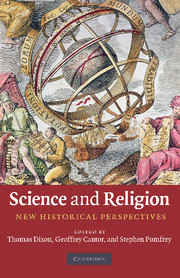1 - Introduction
Published online by Cambridge University Press: 05 May 2010
Summary
John Hedley Brooke is well known to students of science and religion as the slayer of the ‘conflict thesis’ – the hackneyed but popular idea that, ever since the Scientific Revolution, ‘science’ and ‘religion’ have been locked in a deadly battle in which science emerges triumphant. In his Science and religion: Some historical perspectives (1991) and other writings, Brooke has used historical scholarship to show how wrong this picture is.
The systematic dismantling of received ideas about the nature of the scientific enterprise was one of the starting points for this reappraisal of scientific and religious relations. In the 1950s and 1960s historians and philosophers of science began to criticize the ‘Whig’ view of history, according to which science in the past should be seen as slowly but surely approaching the truths put forward by science in the present. The new anti-Whig conception of science underpinned Thomas Kuhn's The structure of scientific revolutions, first published in 1962, which helped set the agenda for future generations of scholars. In Kuhn's picture, the history of science was a discontinuous series of traditions or paradigms dedicated to solving particular puzzles with greater empirical accuracy, but not necessarily approaching some unseen objective reality in the process. This shift in the history of science also inaugurated a new ideal of the historian of science as an observer of the science of past ages, rather than an advocate for modern science.
- Type
- Chapter
- Information
- Science and ReligionNew Historical Perspectives, pp. 1 - 20Publisher: Cambridge University PressPrint publication year: 2010
- 6
- Cited by

